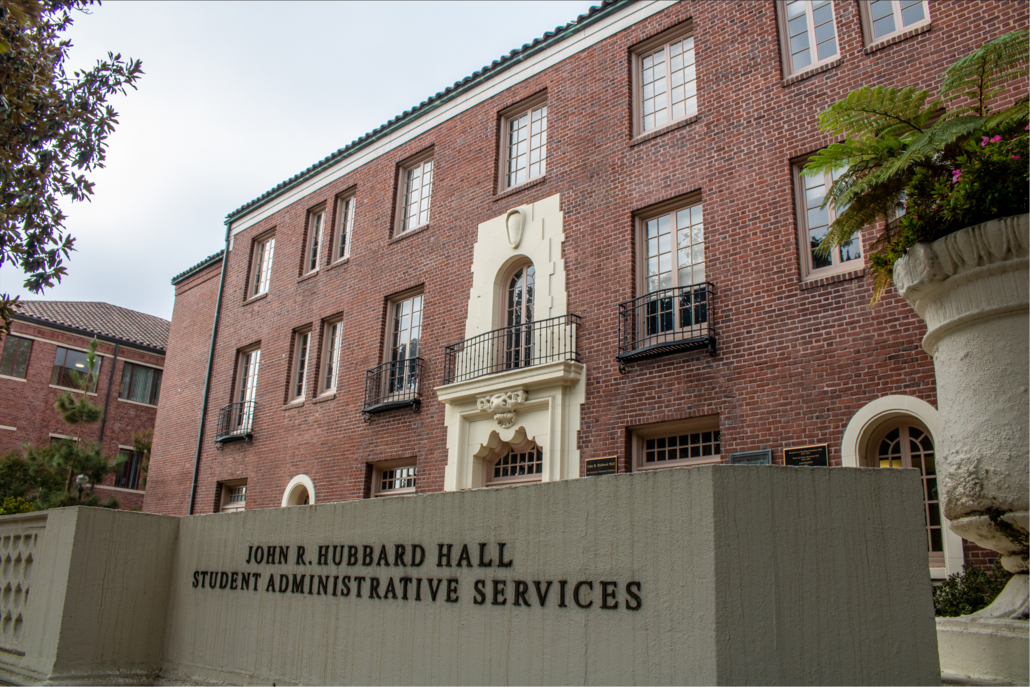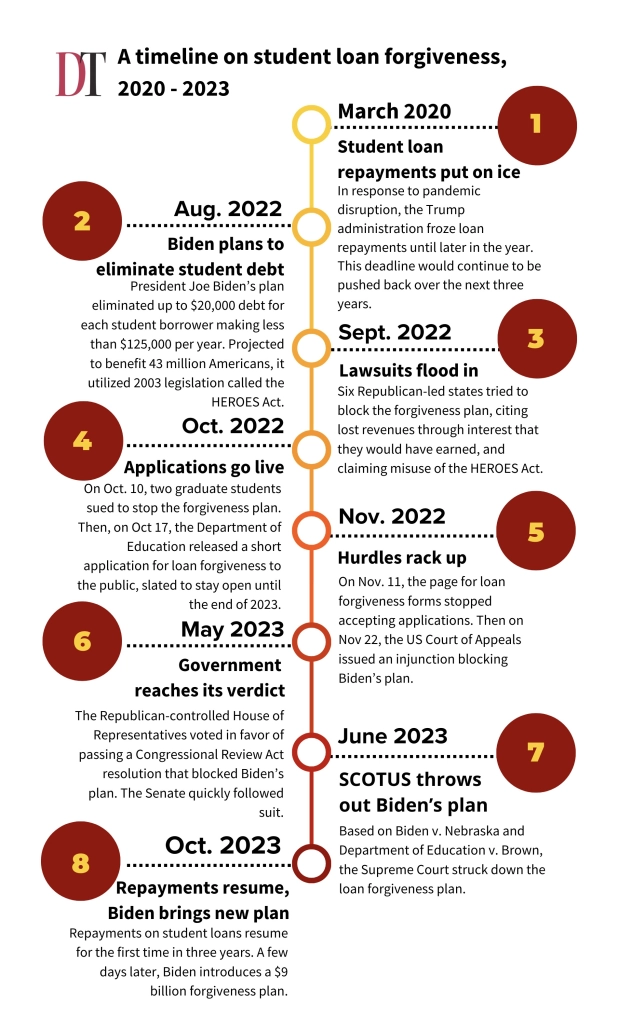Students, experts uncertain over latest loan forgiveness developments
President Biden announced an additional $9 billion in student loan forgiveness.
President Biden announced an additional $9 billion in student loan forgiveness.

The first week of October ushered in two milestones of opposing outcomes for student borrowers. On Oct. 1, for the first time since the incidence of the coronavirus pandemic three years ago, college-goers had to resume repaying their federal student loans to the government. Then, the Biden-Harris administration announced its newest plan Oct. 4 to forgive another $9 billion in student debt — this time targeted toward experienced public service workers.
The Department of Education will distribute $5.2 billion of the $9 billion to existing public service loan forgiveness programs, affecting public service workers, such as U.S. government employees and those who work in emergency services and public safety. Another $2.8 billion will be allocated to existing borrowers who have been repaying loans for 20 years and did not receive the loan forgiveness they were entitled to because of historical administrative inaccuracies.
However, following a tumultuous year for higher education financing in which the Supreme Court threw out Biden’s previous plan to eliminate more than $400 billion in student debt, Robert Dekle — a professor of economics and a supporter of the newest student debt relief plan — characterized Biden’s latest move as “patchwork.”
“It’s great for the people who suffered from government bureaucracies and the slowness of it … [but] it’s not a policy home run,” Dekle said.
The Biden-Harris administration has provided student borrowers, who now have to resume repayments, with some wiggle room. Those who miss a monthly payment from now until September 2024 will not be considered delinquent, and the balance will instead be tacked onto the end of the borrower’s loan term.

Approximately one-third of USC’s students rely on federal student loan programs to some extent. Among them is Emmie Ahmed, a senior majoring in international relations and the global economy, who said she is bemused by the saga surrounding debt forgiveness.
“I wasn’t really counting on the government to come through with the [$400 billion] plan anyways, because I know how radical it is,” Ahmed said. “I’m not surprised that it didn’t.”
For Victor Torres, a senior majoring in business, the saga has meant some of his friends at other universities have had to make uncomfortable decisions.
“I knew some people [who] went back to school purposely [under the impression that their loan would be forgiven],” Torres said. “Some of them even had to drop out of the university, or some of them were in community college and can’t do it.”
Torres, who said he would have relied on federal student loans to fund his studies had he not received a scholarship from USC, also said that while he believes the Biden-Harris administration should continue forgiving student loans, he “doesn’t think that’s gonna happen.”
“A better solution would be to make the cost of attendance lower, and to make it so that the middle class isn’t paying that much to go to school,” Ahmed said. “That’s a long term solution rather than just putting a Band-Aid on.”
While the newly relieved $9 billion will have a “negligible” effect toward the national economy, Dekle said, he also believes that a potential future loan forgiveness program similar to Biden’s initial ambitious plan would be a mistake. The Federal Reserve maintained its interest rate for the first time in months while worries of a recession are being fanned by investors. Student loan forgiveness may act as a stimulant to the economy that would drive up prices.
“The economy is overstimulated and we have high inflation, so we need to weaken the economy,” Dekle said.
We are the only independent newspaper here at USC, run at every level by students. That means we aren’t tied down by any other interests but those of readers like you: the students, faculty, staff and South Central residents that together make up the USC community.
Independence is a double-edged sword: We have a unique lens into the University’s actions and policies, and can hold powerful figures accountable when others cannot. But that also means our budget is severely limited. We’re already spread thin as we compensate the writers, photographers, artists, designers and editors whose incredible work you see in our daily paper; as we work to revamp and expand our digital presence, we now have additional staff making podcasts, videos, webpages, our first ever magazine and social media content, who are at risk of being unable to receive the compensation they deserve.
We are therefore indebted to readers like you, who, by supporting us, help keep our paper daily (we are the only remaining college paper on the West Coast that prints every single weekday), independent, free and widely accessible.
Please consider supporting us. Even $1 goes a long way in supporting our work; if you are able, you can also support us with monthly, or even annual, donations. Thank you.
This site uses cookies. By continuing to browse the site, you are agreeing to our use of cookies.
Accept settingsDo Not AcceptWe may request cookies to be set on your device. We use cookies to let us know when you visit our websites, how you interact with us, to enrich your user experience, and to customize your relationship with our website.
Click on the different category headings to find out more. You can also change some of your preferences. Note that blocking some types of cookies may impact your experience on our websites and the services we are able to offer.
These cookies are strictly necessary to provide you with services available through our website and to use some of its features.
Because these cookies are strictly necessary to deliver the website, refusing them will have impact how our site functions. You always can block or delete cookies by changing your browser settings and force blocking all cookies on this website. But this will always prompt you to accept/refuse cookies when revisiting our site.
We fully respect if you want to refuse cookies but to avoid asking you again and again kindly allow us to store a cookie for that. You are free to opt out any time or opt in for other cookies to get a better experience. If you refuse cookies we will remove all set cookies in our domain.
We provide you with a list of stored cookies on your computer in our domain so you can check what we stored. Due to security reasons we are not able to show or modify cookies from other domains. You can check these in your browser security settings.
These cookies collect information that is used either in aggregate form to help us understand how our website is being used or how effective our marketing campaigns are, or to help us customize our website and application for you in order to enhance your experience.
If you do not want that we track your visit to our site you can disable tracking in your browser here:
We also use different external services like Google Webfonts, Google Maps, and external Video providers. Since these providers may collect personal data like your IP address we allow you to block them here. Please be aware that this might heavily reduce the functionality and appearance of our site. Changes will take effect once you reload the page.
Google Webfont Settings:
Google Map Settings:
Google reCaptcha Settings:
Vimeo and Youtube video embeds:
The following cookies are also needed - You can choose if you want to allow them:
